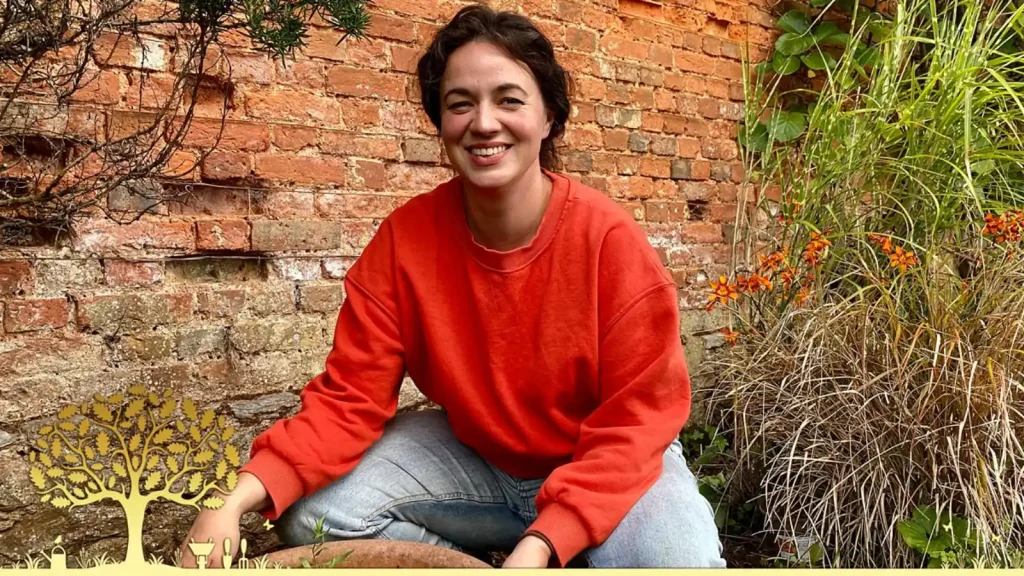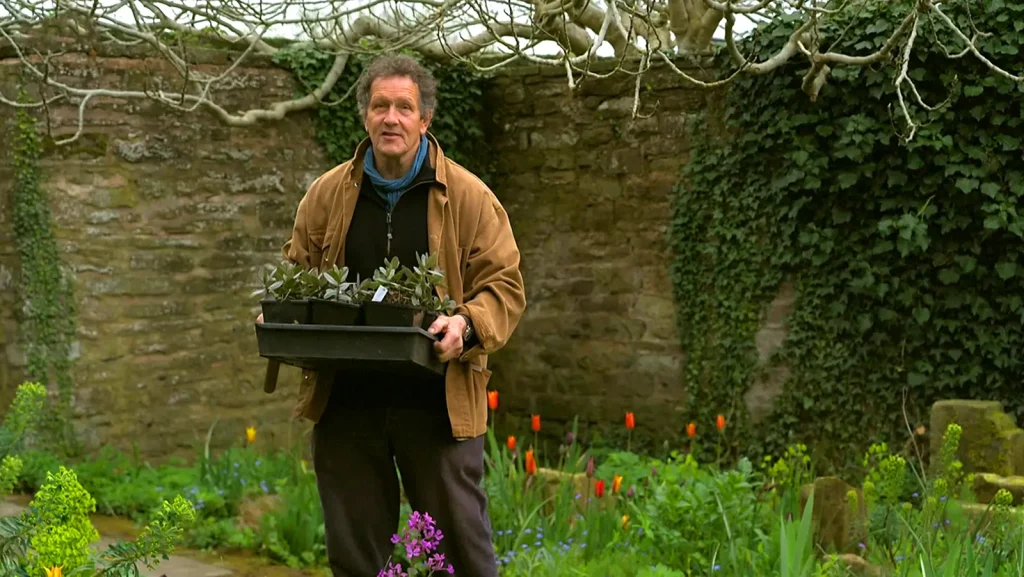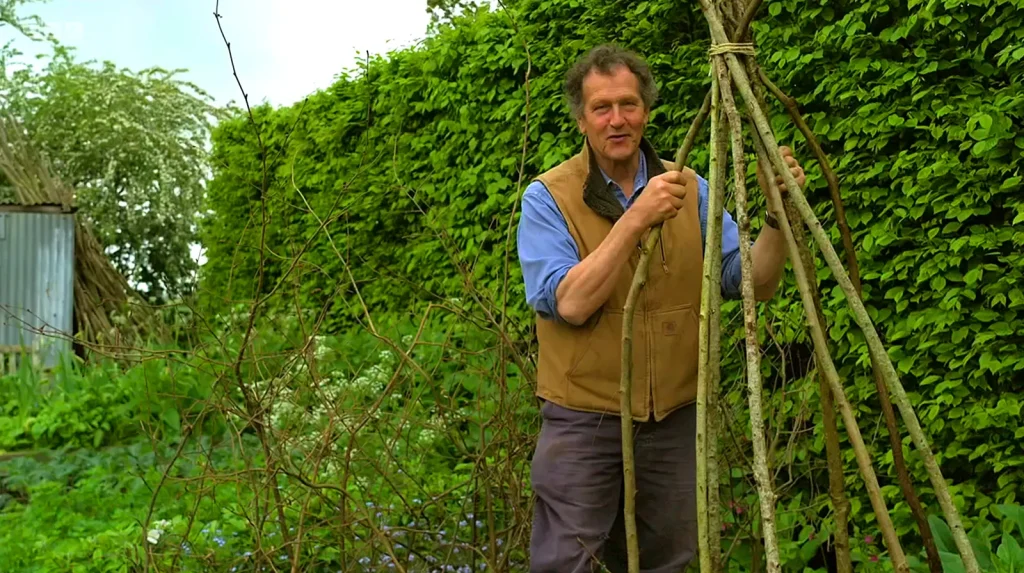In Gardeners World 2024 Episode 27, Frances Tophill returns to the picturesque setting of Powderham Castle in Devon, where the gardens are buzzing with activity. As autumn approaches, Frances takes on the task of planting a fresh herb bed—bringing fragrance and flavor to the heart of the garden. But she doesn’t stop there. Alongside planting, she delves into identifying and collecting seedlings—tiny green promises of future beauty—and explains the simple yet effective technique of dividing perennial plants. For gardeners eager to give their beds a nutrient boost, Frances demonstrates how to make a comfrey liquid feed, a natural fertilizer that’s as easy to make as it is beneficial.
However, Frances’ passion for gardening extends beyond just nurturing plants. This episode has a special focus on the plight of butterflies and pollinators, which are in alarming decline. With her signature warmth and knowledge, Frances shares actionable tips on how even small changes in your garden can help these vital creatures thrive. Think of your garden as a sanctuary, not just for yourself, but for the butterflies, bees, and other pollinators that ensure its ecosystem stays in balance. By planting the right flowers and avoiding harmful pesticides, we can all become guardians of these delicate insects.
Meanwhile, Carol Klein takes us on a journey through a garden that seems to have bottled the very essence of late summer. Bursting with color, the flowers are in full bloom, dancing in the warm breeze like the finale of a well-rehearsed play. Carol, with her infectious enthusiasm, reveals how to make the most of this vibrant time of year. Whether it’s choosing the right plants to extend the season of color or learning how to care for late bloomers, Carol’s advice will inspire gardeners of all levels. It’s a reminder that, even as summer begins to wane, gardens still have plenty of life left in them.
Joe Swift, on the other hand, heads into the city, where he meets a young couple who have transformed their urban space into a lush green haven. In a world often dominated by concrete and noise, their garden is a sanctuary of tranquility. They’ve carefully curated an urban jungle, turning even the smallest spaces into a verdant retreat where they can escape the hustle and bustle of daily life. Joe explores how they’ve cleverly maximized their space, using vertical planting and carefully selected foliage to create a calming environment that feels far removed from the hectic city surrounding them. Their story is a testament to the power of nature, proving that even in the most unexpected places, gardens can flourish.
As the episode unfolds, we are taken to a truly remarkable garden—a peaceful retreat for individuals recovering from life-changing surgery. Here, the healing power of nature is on full display. The space is designed not just for beauty, but for recovery—each flower, each plant, contributing to an atmosphere of serenity and hope. Walking through this garden is like stepping into a world where time slows down, and the natural world offers its gentle embrace. This haven reminds us that gardens aren’t just about aesthetics; they can also be spaces for emotional and physical healing, where nature plays a pivotal role in the recovery process.
Gardeners World 2024 Episode 27
Finally, the episode introduces us to a dynamic mother-and-daughter team who are shaking up the world of houseplants. With a creative flair that sets them apart, they’ve taken the concept of indoor greenery to the next level. Their houseplant displays aren’t just decorations—they are living, breathing art pieces that bring the outside world into the home in a unique and personal way. Whether it’s an unusual arrangement of succulents or a striking display of hanging plants, their work challenges the conventional idea of what a houseplant should be. Through their eyes, houseplants become more than just potted greenery—they are expressions of personality, mood, and creativity.
Throughout this episode, Gardeners’ World once again reminds us of the profound connection between people and plants. Whether you’re planting herbs, helping pollinators, or creating your own urban sanctuary, gardening is more than just a hobby—it’s a way of life. It brings with it the joy of nurturing living things, the satisfaction of seeing them grow, and the deep sense of peace that comes from spending time in nature.
So, whether you’re an experienced gardener with acres of land or a novice working with a few pots on a balcony, this episode offers something for everyone. It’s a celebration of all things green and growing, a testament to the beauty of nature, and a gentle reminder that no matter where we live, we can all cultivate a little more life and color in our world.
Growing Runner Beans: Expert Tips for Maximum Yield
Understanding Runner Beans and Their Benefits
Runner beans are a staple in many home gardens, valued for their high productivity and striking flowers. Easy to grow, they provide a rich harvest throughout the summer and into early autumn. Runner beans are not only productive but also versatile. Climbing varieties add vertical interest to your garden, while dwarf varieties can thrive in containers or small spaces. These beans are also relatively hardy, particularly flourishing in cool, wet summers.
Best Varieties of Runner Beans for Your Garden
Selecting the right variety is crucial to success. Most runner beans are climbers, growing upwards of 2 meters with proper support, making them ideal for small gardens or vertical planting. Dwarf varieties, though smaller in stature, still offer respectable yields and are perfect for raised beds or containers.
Popular Runner Bean Varieties
- Benchmaster: Known for producing smooth, tender beans. These are ideal for large harvests and exhibit excellent exhibition potential.
- Enorma – Elite: Highly productive with fine-textured beans, often used in local shows.
- Firelight: A British-bred variety featuring scarlet flowers and self-fertilizing properties, especially useful in hot, dry summers.
Look for varieties awarded the RHS Award of Garden Merit, ensuring reliability, disease resistance, and heat tolerance.
Preparing the Ground for Runner Beans
Runner beans thrive in rich, well-drained soil. Begin by choosing a sunny, sheltered location, as these plants perform best when protected from strong winds. Before planting, weed the ground thoroughly and enrich it with organic matter, such as well-rotted manure or compost. Aim to add at least two bucketfuls per square meter for optimal soil fertility.
The ideal soil pH for runner beans is around 6.5. If your soil is too acidic, consider adding lime to balance the pH. Preparing the ground weeks in advance allows the soil to settle and improves the beans’ growing conditions.
Sowing Runner Beans: Timing and Techniques
Indoor Sowing: For an earlier crop, start your runner beans indoors in late spring. Use small pots or seed trays, planting seeds about 5 cm deep. Keep the seedlings in a bright, warm place, maintaining a temperature of at least 12°C (54°F). Water regularly to ensure proper growth, and transplant them outdoors once the risk of frost has passed.
Outdoor Sowing: If you prefer direct sowing, wait until all risk of frost has passed. Typically, this means sowing seeds in mid-May in southern regions and early June in northern areas. Ensure the soil temperature has reached at least 12°C. Plant the seeds 5 cm deep, and if using climbing varieties, sow two seeds at the base of each bamboo cane, thinning them to one seedling per cane after germination.
Supporting Climbing Runner Beans
Climbing beans require sturdy supports to maximize yield. The traditional method involves creating an A-frame with bamboo canes. Space the canes 15 to 30 cm apart, sloping them inward and tying the tops together with horizontal canes for extra stability.
Alternatively, you can form an X-frame by tying canes in the middle, providing easier access for harvesting. If space is limited, consider using a wigwam structure—four or five canes tied together at the top, making an attractive and practical addition to any garden.
Watering and Mulching for Healthy Plants
Runner beans are thirsty plants, particularly during flowering and pod formation. Ensure you water them regularly, especially during dry spells or when growing in containers. Adding a layer of mulch, such as well-rotted manure or garden compost, will help retain moisture and suppress weeds. Mulching is essential in July, as it helps prevent the soil from drying out during hot weather.
Encouraging Pods to Form
In some cases, runner bean flowers may fail to set pods. This problem often occurs due to dry soil or excessively hot weather. To encourage pod formation, ensure your soil stays consistently moist and well-mulched. Alkaline soils tend to produce better results, so adding lime may help if your soil is neutral or acidic.
For gardeners in warmer regions, choosing hybrid varieties with French bean parentage, such as ‘Firestorm’ and ‘Moonlight,’ may improve pod set in higher temperatures.
Pruning and Training for Better Yields
Once your climbing beans reach the top of their supports, prune the excess growth to encourage side-shoots lower down. This approach keeps the plants within reach and helps prevent them from becoming top-heavy. Regularly tie in any loose stems to the supports to keep the plants secure.
Harvesting Runner Beans: Best Practices
The key to a prolonged harvest is regular picking. Begin harvesting pods when they are young, tender, and stringless—typically around 15 to 20 cm long. Pods should snap easily, and the beans inside should be small and pale.
Pick beans every two to three days to ensure the plants continue flowering. If pods are left to mature, the plants will stop producing new ones, shortening your harvest season.
Common Problems and Solutions for Runner Beans
Runner beans are generally easy to grow, but they are not without challenges. Watch for common pests like black aphids and slugs, which can damage seedlings and plants. Applying slug deterrents and spraying aphids with water or insecticidal soap can help control infestations.
Beans are also sensitive to frost. Protect your plants by covering them with fleece or cloches during cold spells. Additionally, hot weather can lead to poor pod formation, so ensure your plants are adequately watered and shaded during heatwaves.
Conclusion Gardeners World 2024 Episode 27
In the end, Gardeners World Episode 27 leaves us with more than just tips for our gardens—it leaves us with inspiration. From the tranquil retreat at Powderham Castle to the vibrant urban oasis and the healing power of nature, each story reminds us of the transformative potential of gardening. Whether you’re tending to delicate seedlings or crafting intricate houseplant displays, these moments in nature connect us to something larger than ourselves.

Gardens are more than patches of soil or neatly arranged plants. They are places where we cultivate life, both within and around us. Frances Tophill’s passion for pollinators shows how even the smallest garden can become a sanctuary for wildlife, a space where butterflies flutter through sun-drenched afternoons and bees hum as they work. These are not just scenes of beauty—they are essential parts of our world’s fragile ecosystem, and we all have a role to play in protecting them.
As we journey with Carol Klein and Joe Swift, we are reminded that gardens are also personal sanctuaries. They reflect our personalities, offering peace amidst chaos or bursts of color in the fading light of summer. Whether you have sprawling acres or a small urban nook, the joy of gardening remains the same: it’s a dialogue with nature, a form of self-expression, and a path to well-being.
Ultimately, this episode is a celebration of the human connection to the earth. It’s about finding beauty in the simplest things, like the smell of fresh herbs or the sight of a new bloom. No matter your level of expertise or the size of your garden, this episode serves as a gentle reminder that with a little care, patience, and love, we can all create spaces that nurture not only plants but also our souls. So, as the seasons change, let’s continue to dig deep, plant hope, and let our gardens grow—just like us, full of life and possibility.
FAQ Gardeners World 2024 Episode 27
Q: How can I create a herb bed like Frances Tophill did in Gardeners’ World 2024 Episode 27?
A: Frances recommends starting with a sunny spot. Prepare the soil by adding compost for rich nutrients. Choose herbs like rosemary, thyme, and mint, which will provide fragrance and flavor. Space the plants evenly, and water regularly to help them settle into their new home.
Q: What is the importance of helping pollinators in my garden?
A: Pollinators like butterflies and bees are essential for a healthy garden ecosystem. In Gardeners’ World, Frances explains that small changes, such as planting nectar-rich flowers and avoiding harmful pesticides, can significantly boost pollinator activity, helping your plants thrive and creating a natural balance in your garden.
Q: What are the benefits of using comfrey liquid feed in my garden?
A: Comfrey liquid feed is a natural fertilizer that boosts plant growth by adding essential nutrients to the soil. In Episode 27, Frances shows how easy it is to make by steeping comfrey leaves in water. The result is a nutrient-rich, eco-friendly solution that enhances your plants’ health and vitality.
Q: How do I divide perennial plants like Frances Tophill did in the show?
A: Dividing perennials is a simple technique that promotes healthy growth. Dig around the plant, gently lift it from the soil, and separate the roots into smaller sections. Replant these in fresh soil. Frances demonstrates this process to ensure your plants stay vibrant and produce more flowers in the future.
Q: How can I make my garden a sanctuary for wildlife as suggested in Gardeners’ World 2024?
A: Creating a wildlife sanctuary involves planting a variety of flowers that bloom throughout the year, offering continuous food for pollinators. Avoid synthetic pesticides, add water features, and leave a small area of your garden wild. These efforts will create a haven for insects and birds, encouraging biodiversity.




